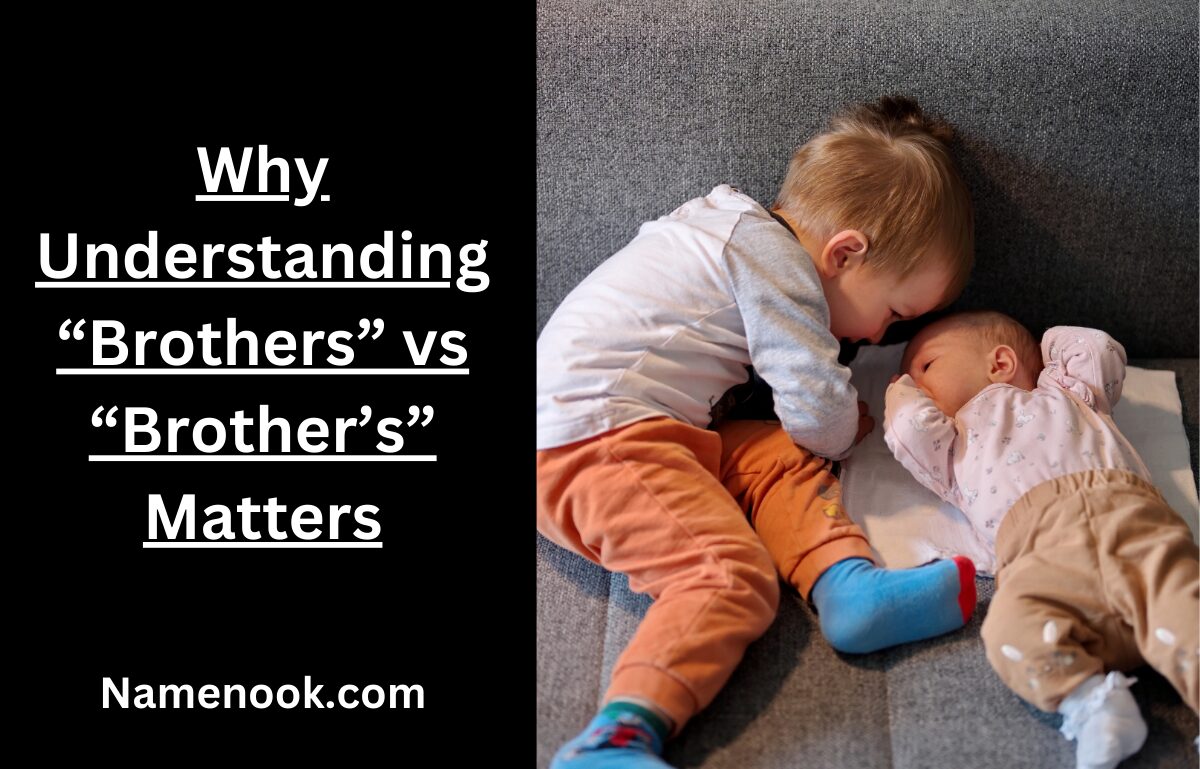Understanding the Difference Between “Brothers” and “Brother’s”
Understanding the difference between ‘brothers’ vs ‘brother’s’ is crucial for mastering English grammar. Learn the rules for plural and possessive forms to improve your writing.
The English language can sometimes be tricky, especially when it comes to subtle differences in spelling and grammar. One common area of confusion is the distinction between “brothers” and “brother’s.” While these two words may look similar at first glance, understanding how and when to use them properly is crucial for writing clearly and accurately.
In this article, we will explore the rules surrounding plural and possessive forms, explain the differences between “brothers” and “brother’s,” and provide examples to help you apply these terms correctly in different contexts. By the end, you’ll have a solid understanding of how to use these words in your writing.
What’s the Difference Between “Brothers” and “Brother’s”?
At the heart of this question is the distinction between plural and possessive forms in English. Let’s break down the rules that govern how these forms are used.
The Apostrophe and Possession: A Key Concept
In English grammar, the apostrophe is a punctuation mark that serves multiple purposes, with one of its most important roles being to indicate possession. When you want to show that something belongs to someone, you add an apostrophe followed by an “s.” However, the apostrophe’s placement varies depending on whether the noun is singular or plural. This is where many people make mistakes.
Singular Possession:
When something belongs to one person or thing, you use the singular possessive form. For example, if one brother owns a toy, you would say:
- “This is my brother’s toy.”
Here, the apostrophe comes before the “s” because only one brother is the owner.
Plural Possession:
When something belongs to more than one person or thing, you use the plural possessive form. The plural of “brother” is “brothers.” When multiple brothers share possession of something, you add an apostrophe after the “s”:
- “These are the brothers’ toys.”
In this case, the toys belong to multiple brothers, and the apostrophe is placed after the “s” because the possession is shared.
Plural Form:
The plural form of “brother” is “brothers,” and it simply means more than one brother. There is no apostrophe in the plural form because it doesn’t indicate possession:
- “I have two brothers.”
- “Both brothers like playing football.”
Singular Possession:
As mentioned, when something belongs to one brother, you use the singular possessive form. Here are some additional examples:
- “My brother’s room is always tidy.”
- “Did you borrow brother’s jacket again?”
- “The brother’s decision was final.”
In each case, the apostrophe is placed before the “s” to indicate possession by one brother.
Plural Possession:
For plural possession, when more than one brother shares ownership of something, the apostrophe is placed after the “s”:
- “The brothers’ toys were left outside in the rain.”
- “I saw the brothers’ car parked by the curb.”
- “The brothers’ opinions were unanimous.”
In these examples, the apostrophe comes after the “s” because the possession is shared by multiple brothers. It’s important not to place the apostrophe before the “s,” as that would indicate singular possession, which is incorrect.
Common Mistakes with “Brothers” vs. “Brother’s”
Even though the rules for using “brother’s” and “brothers” are straightforward, people often make mistakes. These errors can confuse readers and muddy the clarity of the message. Here are two common mistakes:
Mistake #1: Confusing Plural and Possessive Forms
A frequent error is mixing up the plural form “brothers” with the possessive form “brother’s.” This leads to incorrect phrasing and confusion.
Incorrect Example:
- “My brothers’ bicycle is missing.”
- “I’m taking brother’s book to school today.”
The first sentence uses the plural form “brothers” when it should use “brother’s” to indicate one brother’s possession. The second sentence mistakenly uses “brother’s” instead of “brothers’,” implying that only one brother shares possession of the book.
Corrected Sentences:
- “My brother’s bicycle is missing.”
- “I’m taking the brothers’ book to school today.”
Here, “brother’s” refers to one brother’s possession, and “brothers’” correctly indicates shared possession among multiple brothers.
Mistake #2: Misplacing the Apostrophe
Another common mistake is placing the apostrophe in the wrong place, either before the “s” for plural possession or after the “s” for singular possession.
Incorrect Example:
- “I borrowed the brother’s shoes.”
- “The brothers’ car was parked in front of the house.”
In the first sentence, the apostrophe is incorrectly placed before the “s,” suggesting that only one brother owns the shoes. The second sentence correctly uses the plural possessive form “brothers’.”
Corrected Sentences:
- “I borrowed the brothers’ shoes.”
- “The brothers’ car was parked in front of the house.”
Now, the apostrophes are placed correctly to indicate plural possession.
How to Use “Brothers” vs. “Brother’s” Correctly
Let’s break it down clearly to help you master the use of “brothers” and “brother’s”:
-
Brothers (Plural Form)
Use “brothers” when referring to more than one brother without indicating possession. There is no apostrophe in the plural form.Example:
- “I have two brothers.”
- “The brothers are planning a surprise for their parents.”
-
Brother’s (Possessive Form)
Use “brother’s” when something belongs to one brother. The apostrophe is placed before the “s.”Example:
- “I borrowed my brother’s car.”
- “Has anyone seen John’s brother’s wallet?”
-
Brothers’ (Plural Possession)
Use “brothers’” when something belongs to more than one brother. The apostrophe is placed after the “s.”Example:
- “The brothers’ house is on the corner of the street.”
- “The brothers’ laughter filled the room.”
Example Scenarios
Scenario 1: Writing a Family Update Email
Imagine you’re writing an email to your relatives about the upcoming family reunion. Here’s how you might use “brothers” and “brother’s” in a grammatically correct way:
Subject: Family Reunion Update
Dear Family,
I just wanted to let you all know that my brother’s birthday is next month. We’ll be celebrating at his place, and the brothers are really looking forward to it. I’ve attached the details of the event.
I hope to see you all there!
In this email, “my brother’s” refers to one brother’s birthday celebration, while “the brothers” refers to multiple brothers excited about the reunion.
Scenario 2: Family Group Text
Here’s an example of how the terms would appear in a casual family group text:
Sister: Hey, did you guys see brother’s new car?
Brother 1: Yeah, the brothers’ car collection is growing!
Brother 2: It’s all happening this weekend—let’s plan to go together.
In this example, “brother’s” refers to one brother’s new car, while “the brothers’” refers to the shared car collection.
By understanding and applying the rules for “brothers” and “brother’s,” you can avoid common mistakes and write more clearly and confidently!
Family Terms in English Grammar
English grammar includes many family-related terms, such as brother, sister, father, and mother. When indicating possession with these terms, it’s important to follow the same basic rules for apostrophes:
- Father’s – something that belongs to one father
- Fathers’ – something that belongs to more than one father
- Mother’s – something that belongs to one mother
- Parents’ – something that belongs to multiple parents
Apostrophe Rules: Quick Recap
Here’s a quick recap of the key apostrophe rules for possessive nouns:
- Singular possession: The apostrophe goes before the “s” (e.g., brother’s toy).
- Plural form: The apostrophe is not used when you’re simply indicating more than one person or thing (e.g., brothers).
- Plural possession: The apostrophe goes after the “s” (e.g., brothers’ toys).
Grammar Clarification: Plural Form Examples
When using family-related terms in the plural form, remember that no apostrophe is needed unless you’re indicating possession. Here are some examples:
- The brothers played football all afternoon.
- The parents decided to take a trip abroad.
In these cases, you’re simply referring to multiple brothers or parents without indicating possession.
Conclusion: Mastering “Brothers” vs. “Brother’s”
Understanding the difference between “brothers” and “brother’s” is an important part of mastering English grammar, especially when it comes to correctly expressing possession and plurality.
These small distinctions are crucial for writing clearly and accurately, whether you’re drafting a formal letter, sending an email to a family member, or texting informally. Knowing when to use “brothers” vs. “brother’s” ensures your writing is precise and avoids confusion.
By focusing on these grammar rules, you’ll be able to communicate your ideas more effectively and avoid common mistakes.

